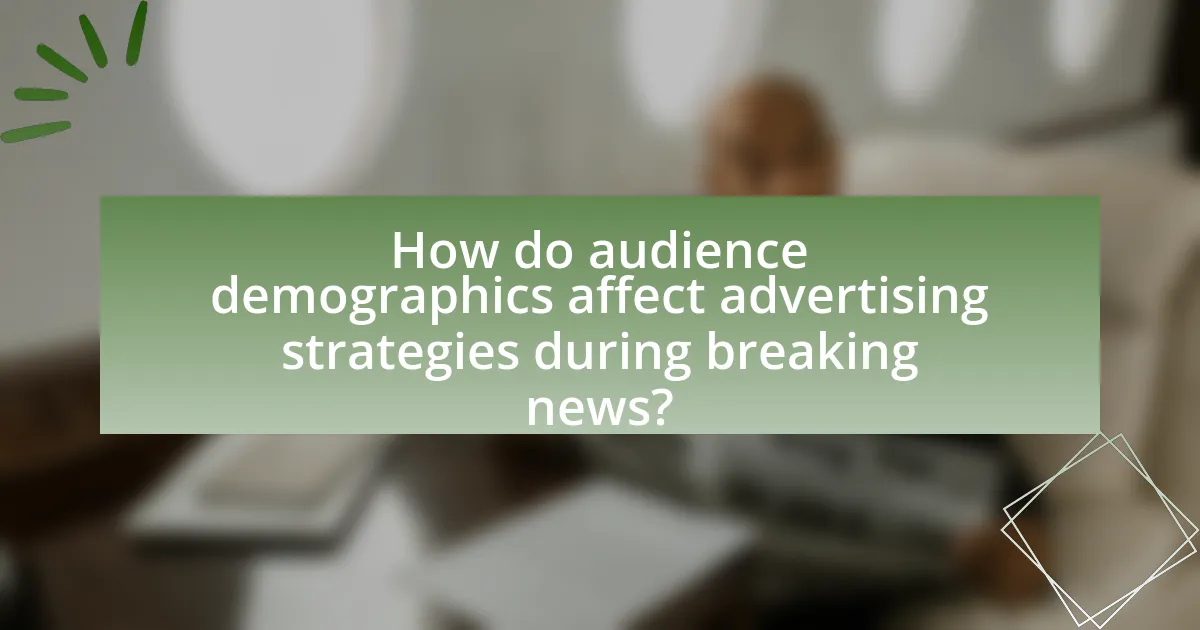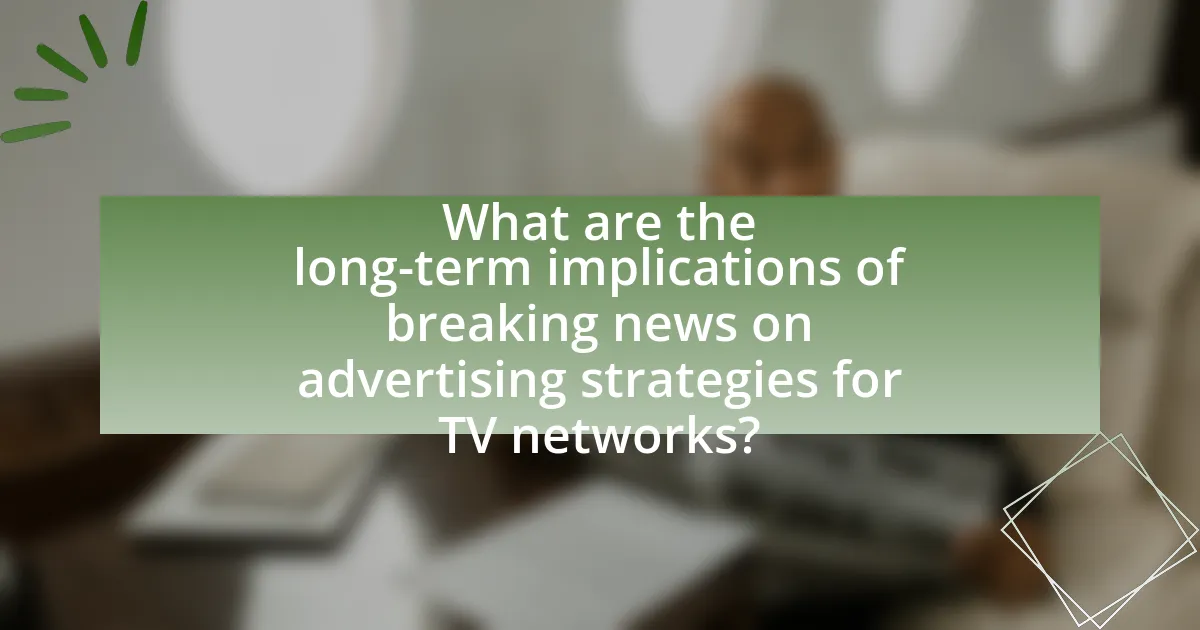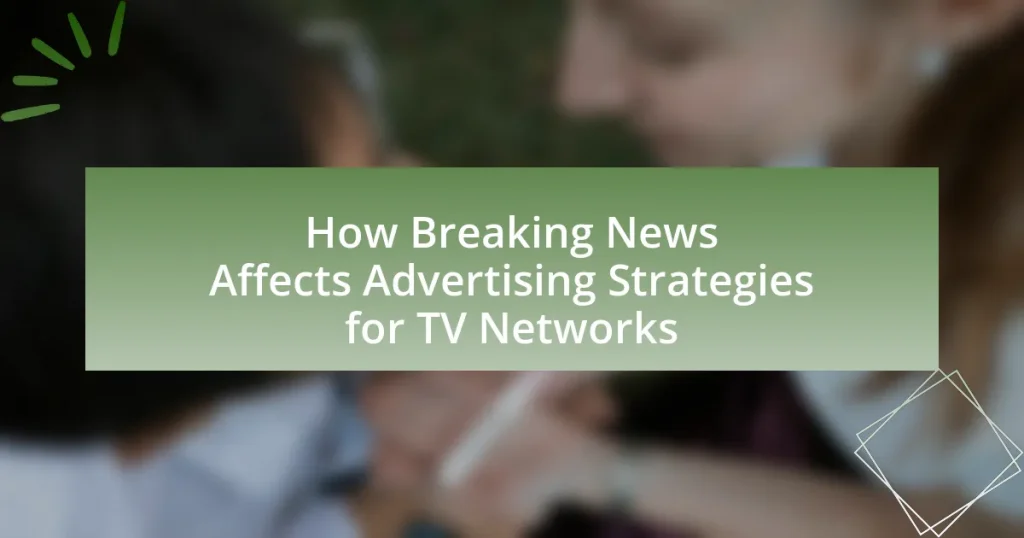The article examines how breaking news impacts advertising strategies for TV networks, highlighting the shift in programming and ad placements during significant events. It discusses the immediate effects of breaking news on advertising, including preemptions and the prioritization of relevant ads, as well as the psychological factors that drive consumer engagement. Additionally, the article explores the challenges networks face in integrating ads with urgent news coverage, the ethical considerations of advertising during sensitive events, and the long-term implications for advertising strategies. Key metrics for measuring ad success during breaking news and emerging trends in advertising are also addressed, providing a comprehensive overview of the evolving landscape of TV advertising in response to breaking news.

How does breaking news influence advertising strategies for TV networks?
Breaking news significantly influences advertising strategies for TV networks by creating opportunities for higher viewership and premium ad pricing. When major events occur, networks often shift their programming to cover these stories extensively, attracting larger audiences. For instance, during the COVID-19 pandemic, networks experienced a surge in viewership, leading to increased demand for advertising slots, which allowed them to charge higher rates. This dynamic illustrates how breaking news can lead to strategic adjustments in ad placements and pricing models, ultimately maximizing revenue for TV networks during critical news cycles.
What are the immediate effects of breaking news on advertising placements?
Breaking news significantly disrupts advertising placements by causing immediate preemptions or cancellations of scheduled ads. This occurs because networks prioritize urgent news coverage over commercial breaks to retain viewer attention during critical events. For instance, during major events like natural disasters or political crises, advertisers often see their spots replaced with news content, leading to a direct loss of ad exposure. Additionally, advertisers may experience a shift in audience demographics, as breaking news can attract a different viewer base, prompting networks to adjust their advertising strategies accordingly. This dynamic illustrates how the urgency and relevance of breaking news can directly impact the effectiveness and scheduling of advertising placements.
How do TV networks adjust their ad schedules during breaking news events?
TV networks adjust their ad schedules during breaking news events by prioritizing news coverage over pre-scheduled advertisements. This adjustment often involves suspending or delaying commercials to provide uninterrupted coverage of significant events, ensuring that viewers receive timely information. For instance, during major incidents like natural disasters or political crises, networks may replace commercial breaks with live updates or expert analysis, reflecting the urgency and importance of the news. This practice is supported by audience engagement metrics, which show that viewership spikes during breaking news, making it more beneficial for networks to focus on content rather than advertisements.
What types of advertisements are prioritized during breaking news coverage?
During breaking news coverage, advertisements that are prioritized include public service announcements, urgent product promotions, and sponsorships related to the news event. These types of advertisements are chosen because they align with the immediate interests and concerns of viewers, ensuring relevance and engagement. For instance, during a natural disaster report, ads for emergency services or safety products are more likely to resonate with the audience, thereby increasing the effectiveness of the advertising. Additionally, networks often opt for advertisers who can provide timely and contextually appropriate messages, enhancing the overall viewer experience while maximizing advertising impact.
Why do advertisers choose to capitalize on breaking news events?
Advertisers choose to capitalize on breaking news events because these events attract high viewer engagement and attention. When significant news occurs, television networks often experience spikes in viewership, providing advertisers with a larger audience for their messages. For instance, during major events like natural disasters or political upheavals, viewership can increase by over 50%, as reported by Nielsen ratings. This heightened engagement allows advertisers to maximize their reach and impact, making their campaigns more effective during these critical moments.
What psychological factors drive consumer engagement during breaking news?
Psychological factors that drive consumer engagement during breaking news include urgency, emotional arousal, and social validation. Urgency compels consumers to seek immediate information, as they perceive breaking news as time-sensitive and critical. Emotional arousal, triggered by the dramatic nature of breaking news, enhances attention and retention, leading to increased engagement. Social validation occurs when consumers share news with others, reinforcing their connection to the event and enhancing their social identity. Research indicates that emotionally charged news stories can increase viewer engagement by up to 50%, demonstrating the significant impact of these psychological factors on consumer behavior during breaking news events.
How does the urgency of breaking news affect ad effectiveness?
The urgency of breaking news significantly enhances ad effectiveness by capturing viewer attention and increasing engagement. When breaking news occurs, audiences are more likely to tune in and remain focused, leading to higher recall rates for advertisements aired during these critical moments. Research indicates that ads shown during breaking news can achieve up to 50% higher viewer engagement compared to regular programming, as the heightened emotional state of viewers makes them more receptive to messaging. This phenomenon is supported by studies showing that emotional arousal, which is amplified during urgent news events, correlates with improved ad retention and effectiveness.
What challenges do TV networks face when integrating ads with breaking news?
TV networks face significant challenges when integrating ads with breaking news, primarily due to the need for timely and relevant content delivery. The urgency of breaking news often requires networks to prioritize real-time updates over scheduled advertising slots, leading to potential revenue loss. Additionally, advertisers may be hesitant to associate their brands with sensitive or tragic events, which can further complicate ad placements. According to a 2020 Nielsen report, 60% of viewers prefer uninterrupted news coverage during critical events, indicating that networks must balance viewer expectations with advertising commitments. This dynamic creates a complex environment where networks must navigate viewer engagement, advertiser sensitivity, and revenue generation simultaneously.
How do technical difficulties impact ad delivery during live news coverage?
Technical difficulties significantly disrupt ad delivery during live news coverage by causing delays or complete failures in ad transmission. When a network experiences issues such as signal loss, equipment malfunctions, or software glitches, it can lead to missed advertising slots, resulting in lost revenue for both the network and advertisers. For instance, during a major breaking news event, if a network cannot switch to pre-scheduled ads due to technical issues, advertisers may not receive the expected exposure, which can diminish the effectiveness of their campaigns. This disruption not only affects immediate ad placements but can also lead to long-term impacts on advertiser relationships and trust in the network’s reliability.
What ethical considerations arise when advertising during sensitive news events?
Advertising during sensitive news events raises significant ethical considerations, primarily centered around the potential for exploitation and insensitivity. Advertisers must navigate the fine line between capitalizing on heightened viewer engagement and respecting the emotional state of the audience affected by the news. For instance, promoting products or services during tragedies can be perceived as opportunistic, leading to public backlash and damage to brand reputation. Research indicates that 70% of consumers believe brands should avoid advertising during crises to maintain ethical standards. Additionally, the timing and messaging of advertisements must be carefully considered to avoid trivializing serious issues, as seen in instances where brands faced criticism for inappropriate ads during natural disasters or social justice movements.

How do audience demographics affect advertising strategies during breaking news?
Audience demographics significantly influence advertising strategies during breaking news by determining the target audience’s preferences, behaviors, and media consumption habits. For instance, younger demographics may prefer digital platforms and social media for news updates, prompting advertisers to focus on online ads and interactive content. Conversely, older audiences might rely more on traditional television broadcasts, leading advertisers to prioritize TV spots during breaking news segments.
Research indicates that during high-stakes events, such as elections or natural disasters, advertisers tailor their messages to resonate with the specific concerns and interests of the demographic groups watching. For example, a Nielsen report shows that viewership spikes among specific age groups during breaking news, which can lead to increased ad rates and targeted campaigns aimed at those demographics. This strategic alignment ensures that advertisers maximize engagement and effectiveness during critical news moments.
What demographic shifts occur during breaking news broadcasts?
During breaking news broadcasts, there is a notable shift in viewership demographics, particularly an increase in younger audiences. Research indicates that breaking news events attract viewers aged 18 to 34 more than regular programming, with Nielsen data showing that this demographic can increase by up to 30% during significant news events. Additionally, there is often a rise in female viewership, as women tend to engage more with emotionally charged news stories. This demographic shift impacts advertising strategies, as networks adjust their ad placements to target these more engaged and younger audiences during such broadcasts.
How do different age groups respond to breaking news advertisements?
Different age groups respond to breaking news advertisements in distinct ways, influenced by their media consumption habits and cognitive processing styles. Younger audiences, particularly those aged 18-34, tend to engage more with digital platforms and social media, leading to a higher likelihood of sharing and interacting with breaking news ads. In contrast, older demographics, such as those aged 55 and above, often prefer traditional media like television and print, resulting in a more passive reception of advertisements during breaking news segments. Research indicates that 70% of younger viewers are more likely to recall advertisements linked to breaking news, while only 40% of older viewers report similar recall rates, highlighting the disparity in engagement levels across age groups.
What role does geographic location play in ad targeting during breaking news?
Geographic location significantly influences ad targeting during breaking news by allowing advertisers to reach audiences most affected by the events. Advertisers can tailor their messages to specific regions, ensuring relevance and maximizing engagement. For instance, during a natural disaster, local businesses can promote emergency services or products, while national brands may adjust their campaigns to resonate with local sentiments. This targeted approach is supported by data indicating that 70% of consumers prefer ads that reflect their local context, enhancing the effectiveness of advertising during critical news events.
How can advertisers tailor their messages for diverse audiences during breaking news?
Advertisers can tailor their messages for diverse audiences during breaking news by utilizing real-time data analytics to understand audience demographics and preferences. This approach allows advertisers to create targeted content that resonates with specific groups, ensuring relevance and engagement. For instance, during significant events, advertisers can analyze social media trends and viewer sentiment to adjust their messaging accordingly, thereby enhancing the effectiveness of their campaigns. Research indicates that personalized advertising can increase engagement rates by up to 50%, demonstrating the importance of audience-specific messaging in dynamic contexts like breaking news.
What strategies can be employed to resonate with various viewer segments?
To resonate with various viewer segments, TV networks can employ targeted content strategies, such as demographic segmentation, personalized messaging, and real-time engagement. Demographic segmentation involves analyzing viewer data to tailor programming that appeals to specific age groups, interests, or cultural backgrounds, thereby increasing relevance and viewer retention. Personalized messaging can be achieved through data analytics, allowing networks to deliver customized advertisements that align with individual viewer preferences, which has been shown to enhance viewer engagement by up to 50%. Real-time engagement during breaking news events, such as interactive polls or social media integration, fosters a sense of community and immediacy, making viewers feel more connected to the content and the network. These strategies are supported by research indicating that targeted advertising can significantly improve viewer response rates and brand recall.
How do cultural factors influence ad content during breaking news events?
Cultural factors significantly influence ad content during breaking news events by shaping the themes, language, and imagery used in advertisements. Advertisers often tailor their messages to align with the cultural sensitivities and values of the audience, ensuring that the content resonates appropriately during sensitive times. For instance, during a national tragedy, brands may choose to adopt a tone of empathy and solidarity, avoiding humor or promotional language that could be perceived as insensitive. Research indicates that ads reflecting cultural relevance can enhance viewer engagement and brand perception, as seen in campaigns that successfully navigated cultural contexts during events like natural disasters or social movements.
What metrics are used to measure the success of ads during breaking news?
The metrics used to measure the success of ads during breaking news include viewership ratings, engagement rates, click-through rates (CTR), and conversion rates. Viewership ratings provide insights into the number of people watching the broadcast, which is crucial during breaking news when audiences spike. Engagement rates reflect how viewers interact with the ads, indicating their effectiveness in capturing attention. Click-through rates measure the percentage of viewers who click on the ad, while conversion rates track the number of viewers who take a desired action, such as making a purchase. These metrics are essential for advertisers to assess the impact of their campaigns in real-time, especially when audience dynamics shift rapidly during significant news events.
How do TV networks analyze viewer engagement with ads during live coverage?
TV networks analyze viewer engagement with ads during live coverage primarily through real-time data analytics and audience measurement tools. These networks utilize technologies such as Nielsen ratings, which provide insights into viewership numbers and demographics, allowing them to assess how many viewers are watching the ads and their engagement levels. Additionally, networks may employ social media monitoring to gauge viewer reactions and interactions related to the ads, providing qualitative data on audience sentiment. This combination of quantitative and qualitative analysis helps networks optimize ad placements and strategies during live events, ensuring they maximize viewer engagement and advertising effectiveness.
What tools are available for tracking ad performance in real-time?
Tools available for tracking ad performance in real-time include Google Analytics, Facebook Ads Manager, and AdRoll. Google Analytics provides detailed insights into website traffic and user behavior, allowing advertisers to measure the effectiveness of their campaigns. Facebook Ads Manager enables advertisers to track engagement and conversion metrics for ads on the platform, offering real-time data on performance. AdRoll specializes in retargeting and provides analytics on ad performance across various channels, helping advertisers optimize their strategies. These tools are widely used in the industry, demonstrating their reliability and effectiveness in real-time ad performance tracking.

What are the long-term implications of breaking news on advertising strategies for TV networks?
Breaking news significantly alters advertising strategies for TV networks by shifting audience engagement and altering ad placement dynamics. As viewers tend to flock to breaking news coverage, networks often prioritize real-time reporting over scheduled programming, leading to a decrease in traditional ad slots. This shift can result in advertisers reassessing their strategies, focusing on more flexible, real-time advertising options such as digital ads or sponsorships that can adapt to the unpredictable nature of news cycles. Furthermore, studies indicate that during major news events, ad effectiveness can increase due to heightened viewer attention, prompting networks to negotiate higher rates for ad placements during these periods. Consequently, the long-term implications include a potential restructuring of ad pricing models and a greater emphasis on integrating advertising with news content to maintain viewer engagement.
How does repeated exposure to breaking news affect brand perception?
Repeated exposure to breaking news negatively affects brand perception by creating a sense of urgency and distraction among consumers. This constant influx of information can lead to brand fatigue, where audiences become desensitized to marketing messages, ultimately diminishing brand recall and loyalty. Research indicates that during high-stress news cycles, consumers prioritize immediate information over brand engagement, resulting in a decline in positive brand associations. For example, a study by the American Psychological Association found that heightened anxiety from breaking news can shift consumer focus away from brands, leading to a 20% decrease in brand favorability during significant news events.
What are the potential risks of associating brands with controversial news stories?
Associating brands with controversial news stories poses significant risks, including reputational damage, consumer backlash, and potential loss of market share. Reputational damage occurs when consumers perceive the brand as insensitive or opportunistic, leading to negative public sentiment. For instance, brands that advertised during the 2020 Black Lives Matter protests faced scrutiny for either supporting or opposing the movement, impacting their public image. Consumer backlash can manifest in boycotts or social media campaigns against the brand, as seen with companies that faced criticism for their association with politically charged events. Additionally, brands may experience a loss of market share if consumers choose competitors perceived as more socially responsible. These risks highlight the importance of careful consideration when aligning brand messaging with controversial topics.
How can brands build loyalty through responsible advertising during breaking news?
Brands can build loyalty through responsible advertising during breaking news by prioritizing sensitivity and relevance in their messaging. By aligning their advertisements with the current emotional climate and addressing the concerns of their audience, brands can demonstrate empathy and social responsibility. For instance, during significant events like natural disasters or social movements, brands that pause regular advertising to provide support or relevant information can foster trust and loyalty among consumers. Research indicates that 70% of consumers are more likely to support brands that show social responsibility during crises, highlighting the effectiveness of this approach.
What trends are emerging in advertising strategies due to breaking news?
Emerging trends in advertising strategies due to breaking news include real-time ad placements, increased use of social media for immediate engagement, and a shift towards contextually relevant messaging. Real-time ad placements allow brands to capitalize on current events, as seen during significant news events where advertisers adjust their campaigns to align with ongoing stories, enhancing viewer engagement. Social media platforms have become vital for brands to respond quickly to breaking news, enabling them to reach audiences instantly and participate in trending conversations. Additionally, contextually relevant messaging has gained traction, with advertisers tailoring their content to resonate with the emotional tone of the news, thereby fostering a deeper connection with viewers. These trends reflect a strategic adaptation to the fast-paced nature of news cycles and audience expectations.
How are digital platforms influencing traditional TV advertising during breaking news?
Digital platforms are significantly influencing traditional TV advertising during breaking news by shifting viewer attention and altering advertising strategies. As audiences increasingly turn to social media and online news outlets for real-time updates, traditional TV networks face pressure to adapt their advertising approaches to maintain viewer engagement. For instance, a study by Nielsen in 2021 found that 60% of viewers use social media to follow breaking news, leading TV networks to prioritize timely and relevant ads that resonate with current events. This shift compels advertisers to create more dynamic and responsive campaigns that can be quickly adjusted to align with the unfolding news narrative, thereby enhancing their effectiveness during critical moments.
What innovations are being adopted by TV networks to enhance ad effectiveness during breaking news?
TV networks are adopting real-time data analytics and targeted advertising technologies to enhance ad effectiveness during breaking news. These innovations allow networks to analyze viewer engagement and demographics instantly, enabling them to serve more relevant ads that resonate with the audience’s immediate interests. For instance, networks like CNN and MSNBC utilize advanced algorithms to adjust ad placements based on live viewership patterns, ensuring that advertisements align with the breaking news context. This strategy has been shown to increase ad recall and effectiveness, as evidenced by studies indicating that targeted ads can improve viewer engagement by up to 50% during critical news events.
What best practices should advertisers follow when planning campaigns around breaking news?
Advertisers should prioritize sensitivity and relevance when planning campaigns around breaking news. This involves closely monitoring the news cycle to ensure that messaging aligns with current events and avoids appearing tone-deaf. For instance, during significant events like natural disasters or national tragedies, advertisers should consider pausing or adjusting their campaigns to reflect the gravity of the situation. Research indicates that brands that demonstrate empathy and social responsibility during crises can enhance their reputation and customer loyalty. Additionally, utilizing real-time data analytics allows advertisers to adapt their strategies quickly, ensuring that their content resonates with the audience’s sentiments and needs during such critical times.




